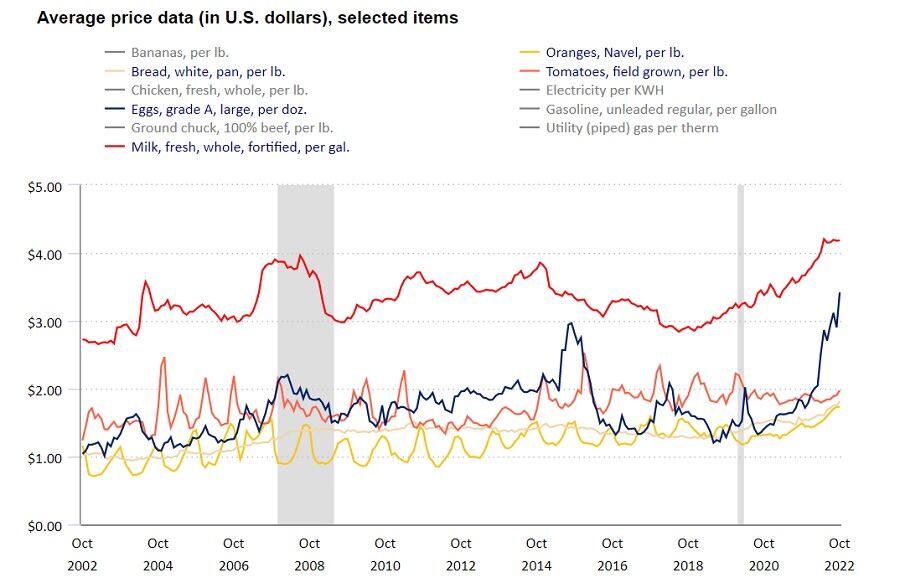But before that happens, consumers likely will continue to see prices at the shelf rise as several manufacturers recently announced additional increases on the horizon or just approved by retailers.
Still, economists and policymakers are buoyed by the Labor Department's report this morning that increases in the Consumer Price Index are lower than recent months. The all items CPI index increased 7.7% in October from a year ago – the smallest 12-month increase since January 2022.
The increase in the price of food consumed at home in October also was the smallest monthly increase in nearly two years – rising 0.4% from the previous month. The slowdown continues a trend that began last August when the increase in grocery prices halved from July – rising only 0.7% compared to 1.3%. The increase in grocery prices held steady in September, continuing to rise 0.7% before last month’s incremental improvement of 0.4%.
The price of food consumed out of home continued to rise at a higher rate of 0.9% in October than that of food at home, but also appears to have stabilized – having held steady at this level since August when it jumped to 0.9% from 0.7%.
According to the October Consumer Price Index, which measures how much Americans pay for goods and services, the increase in grocery prices can be attributed primarily to a 0.8% increase in the price of cereal and bakery products, a 0.6% increase in meat, poultry, fish and eggs and a 0.5% increase in the price of non-alcoholic beverages.
Conversely, the slow-down is coming from fruits and vegetables, the price of which fell 0.9% in October from the previous month, including a 2.4% drop in the price of fresh fruit and a 0.5% dip in the price of fresh vegetables. Dairy prices also fell 0.1% in October, according to the Bureau of Labor Statistics.
President Joe Biden lauded the drop in grocery prices as a “much-needed break in inflation … as we head into the holidays,” and held the overall CPI slowdown out as evidence that “we are making progress on bringing inflation down, without giving up all of the progress we have made on economic growth and job creation.”
As encouraged as Biden is by inflation slowing, he also acknowledged that “it will take time to get inflation back to normal levels – and we could see setbacks along the way.”
Many food industry leaders are echoed this message during recent quarterly calls in which they simultaneously called out the stabilization of some commodity and input costs but also announced additional price increases that will hit store shelves in the coming months – suggesting the economy is far from out of the woods.
‘This is still a difficult time for consumers’
Indeed, despite the current slowdown, the price of food consumed at home for the year remains staggeringly high at 12.4% compared to last October, and the price of food away from home is up 8.6% for the year – leaving food prices overall up 10.9% for the year.
“Today’s numbers make it clear that this is still a difficult time for consumers,” said Andy Harig, FMI – The Food Industry Association vice president, tax, trade, sustainability and policy development.
In response, he added, “grocery stores – and the entire food industry – are doing all they can to ensure Americans have options to stay within their grocery budget and remain committed to working with their customers to help mitigate the impacts of inflation.”
These efforts include leaning heavily on so-called shrinkflation, or the practice of offering smaller packages at the same or a lower entry price point as standard-sized packages pre-pandemic. And while many companies paused promotions to alleviate pressure on strained supply chains, as those supply chains recover some are beginning to offer limited sales and offers at shelf to encourage purchase.
At the same time, many manufacturers are continuing to push through price increases, including Hershey, Kellogg, Mondelez, TreeHouse Foods, and Hain Celestial.
Many of these increases are an effort to offset current and recent cost increases, but several players noted that select commodity and other costs are starting to come down, supply chain challenges are easing and they are better controlling labor costs, which have been a substantial contributor to price increases in recent months.
Hain Celestial CEO Mark Schiller said this week during the company’s first quarter earnings call that he has more visibility now into costs and steps the company has taken to control costs are having a positive impact, so that he is “optimistic that we’ll begin to see some normalizing.”
Still, many, including Mondelez, Kellogg and TreeHouse, are bracing for ongoing double-digit cost inflation through at least the next six to 12 months, which could mean additional pricing that could threaten elasticities that currently are hovering near historic lows.
The delay between when costs and grocery prices stabilizing reflects unique challenges that beset the industry, including the high cost of lowering prices, which often includes new packaging and signage, and significant labor to change shelf tags and update pricing across different retail systems.


